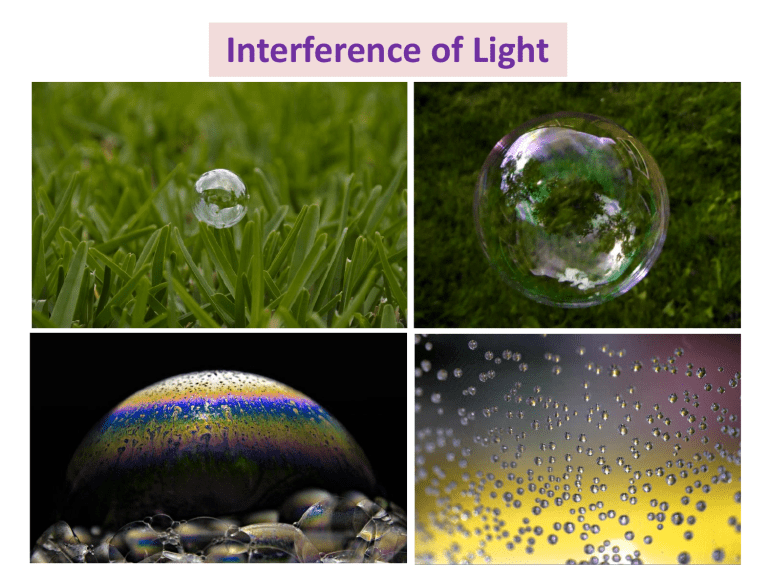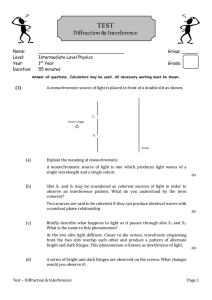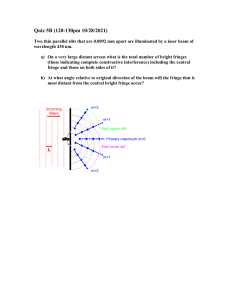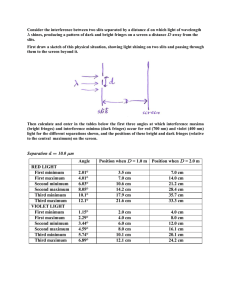
Interference of Light Contents 1. 2. 3. 4. 5. 6. 7. 8. The nature of Light. Corpuscular theory of Light Principle of Superposition Light Definition of Interference of Light. Conditions for Interference. Constructive and destructive interference. Coherent Source. Young’s double slit Experiment and finding the condition for constructive and destructive interference. 9. Equation for the position of Bright and dark fringes. Hence the separation between two consecutive bright or dark fringes. 10. Intensity Distribution of the double-slit interference pattern 11. Phasor addition of waves 12. Multi -slit interference pattern 13. Producing interference pattern using (i) Lloyd’s mirror and (ii) Fresnel’s biprism. 14. Observation of Interference effects in (i) thin films and (ii) Newton's rings 15. Michelson Interferometer and its use in modern Technology. The nature of Light (i) Wave nature (electromagnetic wave) and (ii) Particle nature (bundles of energy called photons) The two most successful theories of light were the corpuscular (or particle) theory of Sir Isaac Newton and the wave theory of Christian Huygens. • Corpuscular theory of Newton (1670) • Light corpuscles have mass and travel at extremely high speeds in straight lines • Huygens (1680) • Huygens argued that if light were made of particles, when light beams crossed, the particles would collide and cancel each other. He proposed that light was a wave. Wavelets-each point on a wavefront acts as a source for the next wavefront. The nature of Light (Cont..) • Huygen assumed that light is a form of wave motion rather than a stream of particles. • Huygenʼs Principle is a geometric construction for determining the position of a new wave at some point based on the knowledge of the wave front that preceded it. • All points on a given wave front are taken as point sources for the production of spherical secondary waves, called wavelets, which propagate in the forward direction with speeds characteristic of waves in that medium. • After some time has elapsed, the new position of the wave front is the surface tangent to the wavelets. • As you might expect, the heuristic idea of Huygens can be fully justified through various derivations associated with the Maxwell equations. The nature of Light (Cont..) The nature of Light (Cont..) The nature of Light (Cont..) • At the end of the 19th century, James Clerk Maxwell combined electricity, magnetism, and light into one theory. He called his theory the electromagnetic theory of light. • According to Maxwell, light was an electromagnetic wave with the same properties as other electromagnetic waves. Maxwell’s theory, however, was unable to explain the photoelectric effect. • In 1900, Max Planck suggested that light was transmitted and absorbed in small bundles of energy called “quanta.” • Albert Einstein agreed with Planck’s theory and explained the photoelectric effect using a particle model of light. The quantum theory combines the two major theories of light, suggesting that light does not always behave as a particle and light does not always behave as a wave. The nature of Light (Cont..) Proofs of Wave Nature • Young's Double Slit Experiment (1807) bright (constructive) and dark (destructive) fringes seen on screen. • Thin Film Interference Patterns. • Poisson/Arago Spot (1820). The nature of Light (Cont..) • Diffraction fringes seen within and around a small obstacle or through a narrow opening. The nature of Light (Cont..) Proof of Particle Nature The Photoelectric Effect (PEE) • Albert Einstein 1905 • Light energy is quantized • Photon is a quantum or packet of energy • Heinrich Hertz first observed the PEE in 1887 • Einstein explained it in 1905 and won the Nobel prize for this. Compton Effect The scattering of photons from charged particles is called Compton scattering after Arthur Compton who was the first to measure photon-electron scattering in 1922. Proof of Particle Nature • The conversion of a photon into an electron-positron pair on its interaction with the strong electric field surrounding a nucleus is called pair production. • The converse of pair production in which an electron and positron combine to produce two photons is known as annihilation of matter. • It is one of the principal ways in which high-energy gamma rays are absorbed in matter. Superposition principle The superposition principle of light waves states that when two or more waves overlap in space, the resultant disturbance is equal to the algebraic sum of the individual disturbances. Coherent sources Two narrow sources of light are said to be coherent if they emit waves having. the same wavelenght (or frequency), the same amplitude, and. a constant phase relation between them. How to make Coherent Sources in Laboratory? Interference of light When two light waves from different coherent sources meet together, then the distribution of energy due to one wave is disturbed by the other. This modification in the distribution of light energy due to super- position of two light waves is called "Interference of light". Conditions for interference ➢ Light must be monochromatic, i.e., involve just a single frequency (single wavelength), i.e. the two sources of light should emit continuous waves of same wavelength and same time period. ➢ Light sources must be coherent, the relative phase is always the same, i.e. the waves emitted by two sources should either have zero phase difference or no phase difference. ➢ Light sources must have the same amplitudes. If these conditions do not hold, one still gets constructive and destructive interference but the interference pattern can change with time or not be complete (destructive interference leads to a decrease in amplitude but not to zero amplitude). Types of interference Constructive interference When two light waves superpose with each other in such away that two interfering waves have a displacement in the same direction so that the crest of one wave falls on the crest of the second wave, and trough of one wave falls on the trough of the second wave, then the resultant wave has larger amplitude than each which is equal to their sum and it is called constructive interference. Destructive interference When two light waves interfering with each other in such away that they have a displacement in the opposite direction so that the resultant displacement is minimum, this is known as destructive interference. Destructive interference has the tendency to decrease the resulting amount of displacement of the medium. Young's interference experiment, also known as the double-slit interferometer, was the original version of the modern double-slit experiment, performed at the beginning of the nineteenth century by Thomas Young (1773-1829) a British scientist. This experiment played a major role in the general acceptance of the wave theory of light. Why Interference Patterns Are Not Standing Waves? The interference pattern in Figure shows bright and dark regions that appear similar to the antinodes and nodes of a standing-wave pattern on a string. While both patterns depend on the principle of superposition, here are two major differences: (1) waves on a string propagate in only one dimension while the light-wave interference pattern exists in three dimensions; (2) the standing-wave pattern represents no net energy flow, while there is a net energy flow from the slits to the screen in an interference pattern. Young’s Double-Slit Experiment From Young’s Double-Slit Experiment setup one can have: i) Describing the Young’s Double-Slit Experiment setup. ii) Derivation of the equation for the condition for constructive and destructive interference iii) Explanation of the assumption L>>d, and d>>, where the terms have their usual meaning. iv) Finding the equation for the position of the bright and dark fringes. v) Finding that (a) the difference between the consecutive 𝑳 bright or dark fringes are same and is given by 𝜷 = and 𝒅 (b) the difference between the consecutive bright and dark 𝑳 fringes is 𝞒 = 𝟐𝒅 Young’s Double-Slit Experiment (Cont…) • In May of 1801, Young performed the double-slit experiment to demonstrate the interference of light waves. • The demonstration would provide solid evidence that light was a wave, not a particle. • Measured the wavelength of light. Young’s Double-Slit Experiment (Cont…) • The slit-width (a) and slit-separation (d) are similar in size to the wavelength of light () • The wave fronts arrive at the two slits from the same source in about the same time - they are in phase ( = 0) • Slits S1 and S2 acts like point-sources by Huygen’s principle. Young’s Double-Slit Experiment (Cont…) • Slits S1 and S2 acting as coherent source with nearly same amplitude. • Light waves from S1 and S2 travelling the distances r1 and r2 interfere at P on the Screen. The screen is placed at a distance L from the Slit axis. • is the angle corresponding to the point P at the slits midpoint Q. Young’s Double-Slit Experiment (Cont…) Assumption that L>>d and <<d, Under these conditions is small; thus, we can use the small angle approximation sin tan Young’s Double-Slit Experiment (Cont…) The fringe spacing or fringe width for the bright fringe is 𝛽 = 𝑦𝑚+1 − 𝑦𝑚 = 𝑚+1 𝜆𝐿 𝑑 𝑚𝜆𝐿 − 𝑑 = 𝜆𝐿 𝑑 Similarly, the fringe spacing or fringe width for the dark fringe 𝛽′ = 𝑦′𝑚+1 − 𝑦′𝑚 = [2(𝑚+1)+1]𝜆𝐿 2𝑑 − [2𝑚+1]𝜆𝐿 2𝑑 = 𝜆𝐿 𝑑 Hence the fringe spacing for consecutive bright or dark fringes 𝜆𝐿 are same and is given as 𝛽 = 𝑑 Centre spacing between two consecutive bright and dark fringes is 𝞒 = 𝑦𝑚 − 𝑦 ′ 𝑚 = 𝑚𝜆𝐿 𝑑 − 2𝑚+1 𝜆𝐿 2𝑑 = 𝜆𝐿 2𝑑 If distance d between slits is decreased, then the angles corresponding to the bright fringes will remain unchanged but the fringes will all become brighter. If wavelength λ of monochromatic light impinging on two-slits experiment increases, then bright fringes all spread further apart. Young’s Double-Slit Fringe Intensity 1. In Derivation of Young’s Double-Slit Experiment, We discussed the locations of only the centers of the bright and dark fringes on a distant screen. 2. we now calculate the distribution of light intensity associated with the double-slit interference pattern. 3. Let us suppose that the two slits represent coherent sources of sinusoidal waves such that the two waves from the slits have the same angular frequency and a constant phase difference . 4. Assuming that the two waves have the same amplitude E0, we can write the magnitude of the electric field at point P due to each wave separately as E1 = E0sint and E2 = E0sin(t+ ) (1) 5. Although the waves are in phase at the slits, their phase difference at P depends on the path difference = r2-r1 = dsin. Young’s Double-Slit Fringe Intensity (Cont…) 6. A path-length difference of one wavelength () produces a phase difference of 2 rad, which is equivalent to no phase difference at all. 7. A path difference of is the same fraction of as the phase difference is of 2. We can describe this mathematically 𝛿 = (2) 2 Which gives us 2 2 = 𝛿 = 𝑑𝑠𝑖𝑛 (3) Young’s Double-Slit Fringe Intensity (Cont…) Young’s Double-Slit Fringe Intensity (Cont…) Young’s Double-Slit Fringe Intensity (Cont…) Phasor Addition of Waves Let us again consider a sinusoidal wave whose electric field component is given by E1 = E0sint and E2 = E0sin(t+ ) Phasor Diagrams for Two Coherent Sources Multiple-slit interference patterns As N, the number of slits, is increased, the primary maxima (the tallest peaks in each graph) become narrower but remain fixed in position and the number of secondary maxima increases. For any value of N, the decrease in intensity in maxima to the left and right of the central maximum, indicated by the blue dashed arcs, is due to diffraction patterns from the individual slits. Producing interference pattern There are different methods for producing coherent sources; but all these methods may be conveniently classified into two main categories. Division of Wavefront: (i) Lloyd’s single mirror, (ii) Fresnel’s biprism, (iii) Fresnel’s double mirror, (iv) Billet’s divided lens and (v) Rayleigh’s interferometer Division of Amplitude: (i) Thin Films, (ii) Newton’s rings, (iii) Michelson’s interferometer, (iv) Jamin’s interferometer and (v) Fabry-perot interferometer Lloyd’s Single Mirror Humphrey Lloyd A light beam after reflection from an optically Developed in 1834 denser medium undergoes a phase change of thus the path difference /2 • From the light source, ray 1 travels directly while the ray 2 is reflected from the mirror surface and interfere with 1 at P on a vertical screen. • The reflected ray can be treated as a ray originating from a virtual source at point S’. • As the rays are reflected from the whole surface of the mirror, its seems that light comes from the coherent source S’ and hence fringe formed in the zone MN. Fringe width MN Lloyd’s Single Mirror (Cont…) • Separation between the slits = SS = d. The screen Distance very large in comparison of the slit separation (D>>d) and the wavelength is very small (<<d). • An interference pattern is indeed observed. However, the positions of the dark and bright fringes are reversed relative to the pattern created by two real coherent sources (Young’s experiment). This occurs because the coherent sources at points S and S’ differ in phase by 180° which in turn results a path extra path difference . 2 • Interference at a distance on the screen, OP = x. At P the path 𝑑.𝑥 𝜆 + 𝐷 2 𝑑.𝑥 𝜆 + = 𝐷 2 difference between the rays 1 and 2 is ∆ = • For the Nth bright Fringe at P we use ∆ = From which 𝑥𝑁𝐵 = (2𝑁−1)𝜆𝐷 2𝑑 𝑁𝜆 Lloyd’s Single Mirror (Cont…) • For the Nth dark Fringe at P we use ∆ = From which 𝑥𝑁𝐷 = 𝑑.𝑥 𝐷 𝜆 2 + = (2𝑁 + 1) 𝜆 2 𝑁𝜆𝐷 𝑑 Fringe width for both bright and dark, 𝛽 = 𝜆𝐷 𝑑 Why central point on the screen is dark instead of being bright? • The central point O on the screen is equidistant from points S and S’. The direct beam from S cannot under go a phase change but the reflected ray has a 180 phase change from the mirror surface. The refractive index of the mirror (medium 2) higher than the medium 1 (Air). • This can be explained based on the string analogy. The reflected pulse on a string undergoes a phase change of 180° when reflected from the boundary of a denser medium, but no phase change occurs when the pulse is reflected from the boundary of a less dense medium. Lloyd’s Single Mirror (Cont…) • Similarly, an electromagnetic wave undergoes a 180° phase change when reflected from a boundary leading to an optically denser medium (defined as a medium with a higher index of refraction), but no phase change occurs when the wave is reflected from a boundary leading to a less dense medium. Fresnel’s Biprism • Augustin-Jean Fresnel was French Physicist Contributed significantly to the establishment of the wave theory of light and optics. • He gave a simple arrangement for the production of Interference Pattern. • Biprism consists of two identical thin prism of very small refracting angle (30’ to 1) with their bases joined together. • Thus the biprism BP is a thin glass prism of obtuse angle 179 and acute angle is about 30 on both sides. • A monochromatic light of wavelength from a source passes through the narrow slit S. • The biprism is placed in front of the slit with its refracting edge parallel to slit. Fresnel’s Biprism (Cont…) • The light from S is allowed to fall symmetrically on the biprism BP. The light beams emerging from the upper and lower halves of the prism appears to come from two virtual sources S1 and S2 which act as coherent sources. • The cones of light BS1E and AS2C, diverging from S1 and S2 are superposed and the interference fringes are formed in the overlapping region BC of the Screen. Fresnel’s Biprism (Cont…) • Let us suppose the distance between S and S is d. • Moreover, the two emergent wavefronts intersect at small angles and hence the fundamental condition of interference, i.e. sin tan approximation is satisfied. • Interference fringes of equal width are produced in the overlapping region BC of the screen but beyond B and C, fringes of large width are produced due to Diffraction. • The midpoint O of BC is equidistant from S and S, hence this point has maximum intensity. • Fresnel’s Biprism working mechanism totally same as that of the Youngs-double slit experiment. So, on both sides of O, alternately bright and dark fringes are produced. Fresnel’s Biprism (Cont…) • For the Nth bright fringe, the distance, 𝑥𝐵𝑟𝑖𝑔ℎ𝑡 = 𝑁𝜆𝐷 , 𝑑 N = 0, 1, 2, 3, ….etc • For the Nth dark fringe, the distance, 𝑥𝑑𝑎𝑟𝑘 = (2𝑁+1)𝜆𝐷 , 2𝑑 N = 0, 1, 2, 3, ….etc • Hence the fringe width for both bright and dark, 𝛽 = 𝜆𝐷 𝑑 Advantages Fresnel’s biprism ➢ For the Young’s slits experiment, we must approximate that the slits act as point sources. This however is not the case, since the slits have finite width. This finite size of the secondary slits gives rise to unwanted diffraction effects which causes errors. The Fresnel biprism overcomes this problem of extended secondary slits by replacing them with virtual slits which are point-like. Fresnel’s Biprism (Cont…) ➢ As this experiment is analogous to Young slits, the formula above holds with the minor exception that d can not be measured directly since the two slits are purely virtual. ➢ Instead, d is determined by placing a converging lens between the biprism and the screen and forming real images of the virtual slits on the screen. From the optical magnification formula. Interference effects by in thin films Interference effects in Bubbles Interference effects by in thin films (Cont…) Newtons and Hooke observed and developed the interference phenomenon due to multiple reflections from the surface of thin transparent materials. Everyone is familiar with the beautiful colours produced by thin film of oil on the surface of water and also by the thin film of a soap bubble. In the case of thin film interference takes place due to (i) reflected light and (ii) transmitted light. • Let us consider a transparent film of thickness t and refractive index . A ray AB is incident on the upper surface of the film partly reflected R1 and partly refracted along BC. At C part of it is reflected along CD and finally emerges out as R2. • The difference in path between the two rays R1 and R2 can be calculated. In the Figure, BC = CD =CE, DN⊥R1 and BM⊥CD. The incident angle is i and the refracted angle is r. Interference effects by in thin films (Cont…) Interference effects by in thin films (Cont…) • The optical path difference is given by x = (BC+CD)-BN = DE-BN Here = 𝑠𝑖𝑛 𝑖 sin 𝑟 = 𝐵𝑁/𝐵𝐷 𝐷𝑀/𝐵𝐷 = 𝐵𝑁 𝐷𝑀 BN = 𝐷𝑀 Hence, x = (DE-DM) = ME In the right BME 𝑐𝑜𝑠 𝑟 = 𝑀𝐸 𝐵𝐸 ME = 𝐵𝐸𝑐𝑜𝑠 𝑟 = 𝐵𝐹 + 𝐹𝐸 𝑐𝑜𝑠 𝑟 = 2𝑡𝑐𝑜𝑠 𝑟 So, the optical path difference, 𝑥 = 2𝑡𝑐𝑜𝑠 𝑟 According to EM theory, a ray of light travelling in air and getting reflected at the surface of a denser medium, undergoes an automatic phase change of π (or) an additional path difference of λ/2. Since the reflection at B is at the surface of a denser medium, there is an additional path difference λ/2 . The effective path difference in this case, 𝑥𝑡𝑜𝑡𝑎𝑙 = 2𝑡𝑐𝑜𝑠 𝑟 + 2 Interference effects by in thin films (Cont…) • If the path difference xtotal = m, where m = 0, 1, 2, 3, 4,….. etc., constructive interference takes place and the film appears bright. 2𝑡𝑐𝑜𝑠 𝑟 + = 𝑚 or, 𝟐𝒕𝒄𝒐𝒔 𝒓 = (𝟐𝒎 − 𝟏) 2 𝟐 • If the path difference 𝑥𝑡𝑜𝑡𝑎𝑙 = (2𝑚 + 1) , where m = 0, 1, 2, 3, 2 4, ….. etc., destructive interference takes place and the film appears darks. 2𝑡𝑐𝑜𝑠 𝑟 + = (2𝑚 + 1) or, 𝟐𝒕𝒄𝒐𝒔 𝒓 = 𝒎 2 2 • If light is incident normally i = 0 and hence r = 0. Therefore the condition for bright fringe is 2𝑡 = (2𝑚 − 1) and for dark 2 fringe is 2𝑡 = 𝑚. • For normal incidence, about 4% of the incident light is reflected and 96% is transmitted. There is a small difference in the amplitudes of R1 and R2. Interference effects by in Newton’s ring • Isaac Newton demonstrated in 1704. • When a plano-convex lens of long focal length is placed on a plane glass plate, a thin film of air is enclosed between the lower surfaces of the lens and the upper surface of the plate. • The thickness of the air film is very small at the point of contact and gradually increases from the centre onwards. Interference effects by in Newton’s ring (Cont…) • The fringes produced with monochromatic light are circular and concentric with the point of contact as the centre. • Near the centre, circular fringe width is higher. As the air film thickness increases, the width of the bright or dark fringes decreases. • When viewed with white light, the fringes are coloured. With monochromatic light, bright and dark fringes are produced in the air film. Interference effects by in Newton’s ring (Cont…) • In the picture, S = Monochromatic light source of wavelength allows to pass through the lens L1. B = Glass plate placed at 45 reflects a part of the incident light towards the air film enclosed by the lens L and the glass plate G. M = Microscope which is used to view the dark and bright interference pattern formed in the air film. • The centre of the newton’s ring is dark, as there is not path difference between the interfering rays. R = radius of curvature of the plano-convex lens. r = radius of the newton’s rings For air, refractive index = 1 According to EM theory (Stokes theory), a ray of light travelling in air and getting reflected at the surface of a denser medium, undergoes an automatic phase change of π (or) an additional path difference of λ/2. The point B is backed by a rarer medium (air) while the point D is backed by a denser medium (glass). Thus there will be an additional path difference λ/2 between the rays BC and BDEF corresponding to this additional phase difference of π. The effective path difference in this case, 𝑥𝑡𝑜𝑡𝑎𝑙 = 2𝑡𝑐𝑜𝑠 𝑟 ± 2 The two rays will interfere constructively when 2𝑡𝑐𝑜𝑠 𝑟 − = 𝑛 or, 𝟐𝒕𝒄𝒐𝒔 𝒓 = 𝟐𝒏 + 𝟏 with n = 1, 2, 3, ….. 2 𝟐 The rays will interfere destructively when 2𝑡𝑐𝑜𝑠 𝑟 − = (2𝑛 − 1) or, 𝟐𝒕𝒄𝒐𝒔 𝒓 = 𝒏 with n = 1, 2, 3, ….. 2 2 The experimental arrangement is so designed that the light incident at i = 0 and hence r = 0. Therefore the condition for bright fringe is 2𝑡 = (2𝑛 + 1) and for dark 2 fringe is 2𝑡 = 𝑛. Interference effects by in Newton’s ring (Cont…) • The radius of the nth bright fringe ring, 𝑟= • The radius of the mth (2𝑛−1)𝜆𝑅 2𝜇 = (2𝑛−1)𝜆𝑅 2 dark fringe ring, 𝑟 = 𝑛𝜆𝑅 𝜇 = 𝑛𝜆𝑅 • When n = 1, the radius of the dark fringe is zero and the radius of the bright 𝜆𝑅 . 2 Therefore, the centre is dark. • The centre of the ring dark in Newton’s Rings experiment with reflected light is dark because at the point of contact the path difference is zero but one of the interfering ray is reflected so the effective path difference becomes λ/2 thus the condition of minimum intensity is created hence centre of ring pattern is dark. Interference effects by in Newton’s ring (Cont…) • Alternately dark and bright rings are produced. • In terms of diameter of the newton’s ring, the wavelength of the light can be determined from 2 𝐷𝑛+𝑝 − 𝐷𝑛2 𝜆= 4𝑝𝑅 Where Dn+p and Dn are the diameter of the (n+p)th and nth rings. Michelson Interferometer FTIR Fourier Transform Infrared Spectroscopy LIGO Laser Interferometer Gravitational Wave Observatory 2017 Nobel Prize in Physics to Rainer Weiss, Barry C. Barish, and Kip S. Thorne. Weiss for the detection of Gravitational Waves: A concept Given by Albert Einstein Dipankar Talukdar and Selim Shahriar were in the LIGO team Mathematical Problems 1) A viewing screen is separated from a double-slit source by 1.2 m. The distance between the two slits is 0.030 mm. The second-order bright fringe (m = 2) is 4.5 cm from the center line. (a) Determine the wavelength of the light. (b) Calculate the distance between adjacent bright fringes. 2) A light source emits visible light of two wavelengths: = 430 nm and = 510 nm. The source is used in a double-slit interference experiment in which L = 1.50 m and d = 0.025 0 mm. (b) Find the separation distance between the third-order bright fringes. (b) What if we examine the entire interference pattern due to the two wavelengths and look for overlapping fringes? Are there any locations on the screen where the bright fringes from the two wavelengths overlap exactly? 3) Suppose you pass light from a He-Ne laser through two slits separated by 0.0100 mm and find that the third bright line on a screen is formed at an angle of 10.95º relative to the incident beam. (a) What is the wavelength of the light? (b) Interference patterns do not have an infinite number of lines, since there is a limit to how big m can be. What is the highest-order constructive interference possible with the system described in (a)? 4) Calculate the angle for the third-order maximum of 580-nm wavelength yellow light falling on double slits separated by 0.100 mm. 5) What is the separation between two slits for which 610-nm orange light has its first maximum at an angle of 30.0°? 6) Find the distance between two slits that produces the first minimum for 410-nm violet light at an angle of 45.0°. 7) What is the highest-order maximum for 400-nm light falling on double slits separated by 25.0 μm? 8) (a) If the first-order maximum for monochromatic light falling on a double slit is at an angle of 10.0°, at what angle is the second-order maximum? (b) What is the angle of the first minimum? (c) What is the highest-order maximum possible here? 9) (a) Find the thickness of a soap film (µ = 1.33) for a strong first-order reflection of yellow light, = 600 nm (in vacuum). Assume normal incidence. (b) What is the wavelength of the light in the film? 10) A glass plate 0.40 micron thick is illuminated by a beam of white light normal to the plate. The index of refraction of the glass is 1.50. What wavelength within the limits of the visible spectrum (= 4010-6 cm to = 70 10-6 cm) will be intensified in the reflected beam? 11) Newton’s rings are observed when plano-convex is placed convex side down on a plane glass surface and the system is illuminated from above by monochromatic light. The radius of the first bright ring is 1 mm. (a) If the radius of the convex surface is 4 m, what is the wavelength of the light used? (b) If the space between the lens and the flat surface is filled with water, what is the radius of the first bright ring?



